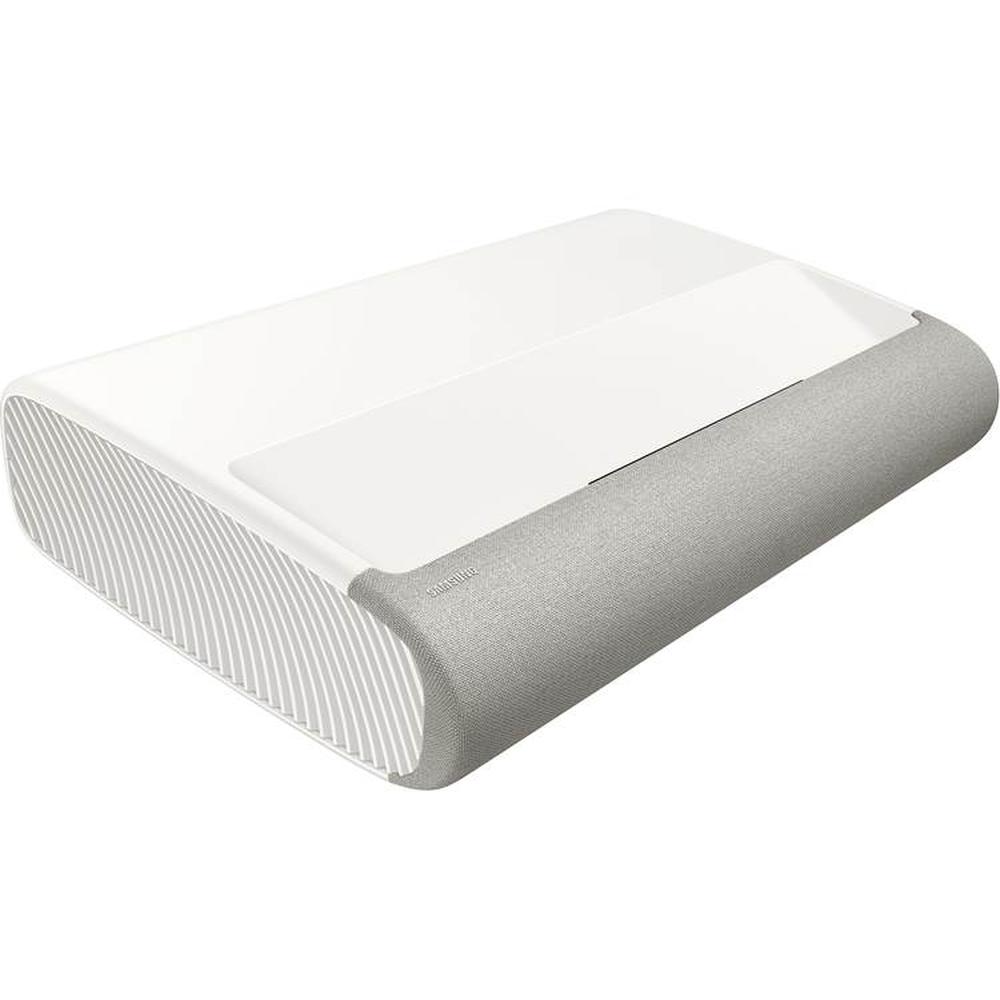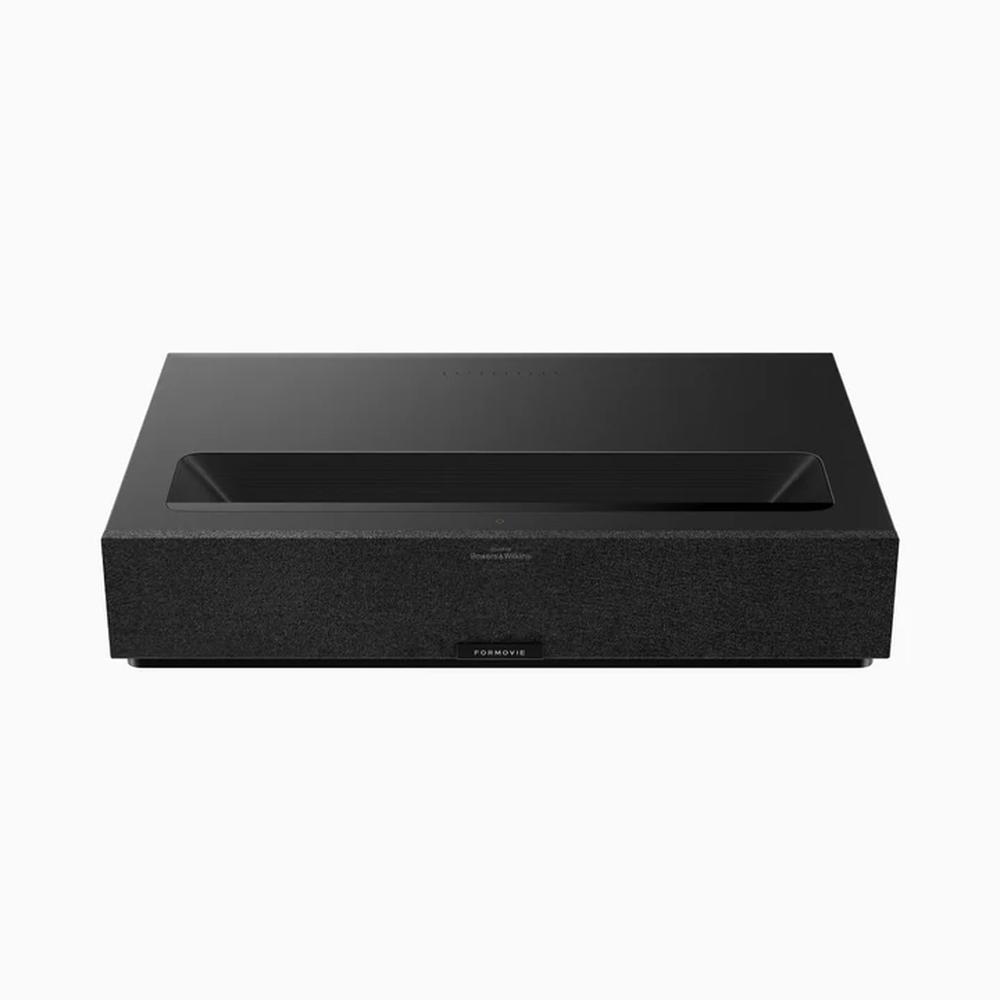
When it comes to creating a high-end home theater experience without a traditional long-throw projector setup, Ultra Short Throw (UST) laser projectors have become the go-to solution. Today we're comparing two leading options: the brand new Samsung Premiere 9 ($5,999) and the Formovie Theater Premium ($2,799), both released in early 2024.
Unlike traditional projectors that need to sit far back in a room, UST projectors use specialized optics to create massive images from just inches away from your wall. This clever design lets you place them in a media cabinet directly below your screen, making them much more practical for many homes.
Both of these models use advanced triple laser light sources, which means they have separate red, green, and blue lasers rather than a white light source with color wheels. This technology provides better color accuracy and longer lifespans than traditional lamp-based projectors.
The Samsung Premiere 9 boasts an impressive 3,450 ISO lumens, while the Formovie Theater Premium delivers 2,200 ISO lumens. What does this mean in real terms? ISO lumens are a standardized measurement of actual visible brightness, unlike regular lumens which can be misleading. The Samsung's significant advantage here means it can maintain vivid images even with some lights on - perfect for casual viewing or sports watching parties.
The Formovie isn't dim by any means, but it's best suited for controlled lighting conditions. In a proper dark home theater setting, both projectors can deliver excellent picture quality, but the Samsung maintains its punch better when ambient light creeps in.

Here's where things get interesting. While the Samsung offers excellent color accuracy out of the box, the Formovie actually covers a wider color gamut - 107% of the BT.2020 color space, which is the gold standard for HDR content. Both projectors support HDR10 and HDR10+ formats, but the Formovie adds Dolby Vision support, which can provide better dynamic range adaptation scene-by-scene.
The Samsung counters with its new Quantum 4K processor, which does an excellent job upscaling lower resolution content and managing HDR tone mapping. This means non-4K content often looks better on the Samsung, which is important since not everything we watch is native 4K.
In a dark room, the Formovie has a slight edge in contrast performance, with measured contrast ratios around 3000:1. The Samsung shows slightly elevated black levels, though its higher brightness helps maintain perceived contrast in brighter conditions. Neither projector can match the perfect blacks of an OLED TV, but both provide satisfying contrast for projection systems.

Both projectors feature automatic geometry correction and focus systems, but they handle it differently. The Samsung's 0.19:1 throw ratio means it can sit slightly closer to the wall than the Formovie's 0.21:1 ratio. For a 100-inch image, that's about 3 inches difference in placement depth.
The Samsung's setup process is more polished, with an excellent smartphone-based alignment system. The Formovie's setup isn't difficult, but it's not quite as refined.
The Samsung Premiere 9 runs on the latest version of Tizen OS, the same system used in their smart TVs. It includes Samsung's Gaming Hub for cloud gaming services and has a reasonably low input lag of around 55ms in game mode. While not ideal for competitive gaming, it's fine for casual players.
The Formovie Theater Premium uses Android TV 11.0, offering excellent app compatibility and Google Assistant integration. Its measured input lag of around 41ms is slightly better than the Samsung, though neither is optimal for serious gaming.
Both projectors integrate impressive sound systems that outperform most TVs. The Samsung features a 40W 2.2.2 channel system with upward-firing speakers for Dolby Atmos effects. The Formovie partners with Bowers & Wilkins for its 30W system, which delivers excellent clarity but less overall power than the Samsung.
While serious home theater enthusiasts will still want a separate audio system, both projectors can serve as all-in-one solutions for more casual setups.
The $3,200 price difference between these projectors can't be ignored. The Samsung Premiere 9 justifies its premium with superior brightness, better processing, and a more powerful sound system. However, the Formovie Theater Premium delivers 80-90% of the Samsung's performance at less than half the price.
Choose the Samsung Premiere 9 if:
Choose the Formovie Theater Premium if:
Both projectors use triple laser light sources rated for approximately 20,000 hours of use. At four hours per day, that's nearly 14 years of viewing. Neither requires lamp replacements like traditional projectors.
Both manufacturers provide firmware updates, though Samsung has a better track record for long-term software support. The Android TV platform on the Formovie provides excellent app compatibility but may feel dated sooner than Samsung's continuously updated Tizen OS.
These projectors represent two excellent but different approaches to UST projection. The Samsung Premiere 9 is the more polished, powerful option for those who can afford it, while the Formovie Theater Premium offers tremendous value without major compromises.
For most users, I'd recommend the Formovie unless you specifically need the Samsung's extra brightness or have the budget for its premium features. Both represent the cutting edge of UST projection technology, and either one can serve as the centerpiece of an impressive home theater setup.
| Samsung Premiere 9 | Formovie Theater Premium |
|---|---|
| Price - Base cost before installation | |
| $5,999 | $2,799 |
| Brightness - Critical for rooms with ambient light | |
| 3,450 ISO lumens (excellent for bright rooms) | 2,200 ISO lumens (best in controlled lighting) |
| HDR Support - Impacts color and contrast quality | |
| HDR10, HDR10+, HLG | HDR10, HDR10+, HLG, Dolby Vision |
| Color Gamut - Determines color accuracy and vibrancy | |
| Standard HDR coverage | 107% BT.2020 (wider range) |
| Throw Ratio - Affects required placement distance | |
| 0.19:1 (needs less space) | 0.21:1 (needs slightly more space) |
| Sound System - Built-in audio quality | |
| 40W 2.2.2 channel with Dolby Atmos | 30W Bowers & Wilkins system |
| Smart Platform - Streaming and app access | |
| Tizen OS with Gaming Hub | Android TV 11.0 |
| Gaming Performance - Input lag for gaming | |
| ~55ms input lag | ~41ms input lag |
| Screen Size Range - Flexibility of setup | |
| 100" to 130" | 80" to 150" |
| Light Source Lifespan - Long-term durability | |
| 20,000 hours | 20,000 hours |
| Operating System Support - Future updates | |
| Regular Tizen updates, excellent long-term support | Standard Android TV updates |
| Additional Features - Extra capabilities | |
| Built-in TV tuner, Object Tracking Sound | Dolby Vision, Google Assistant Far-field Voice |
The Formovie Theater Premium at $2,799 offers better value for most users compared to the Samsung Premiere 9 at $5,999. While the Samsung has higher brightness and better audio, the Formovie delivers comparable image quality for less than half the price.
The Samsung Premiere 9 with 3,450 ISO lumens performs significantly better in bright rooms compared to the Formovie Theater Premium's 2,200 ISO lumens. If you plan to watch during daytime or with lights on, the Samsung is worth the premium.
Yes, both offer comprehensive smart features. The Samsung Premiere 9 uses Tizen OS with Gaming Hub, while the Formovie Theater Premium runs Android TV 11.0. Both support major streaming services like Netflix and Disney+.
The Samsung Premiere 9 has a more polished setup process with smartphone-based alignment tools. The Formovie Theater Premium setup is straightforward but less refined.
The Formovie Theater Premium offers slightly better contrast and wider color gamut with Dolby Vision support. The Samsung Premiere 9 provides brighter images and better upscaling of non-4K content.
Both have good built-in audio. The Samsung Premiere 9 features a 40W 2.2.2 channel system, while the Formovie Theater Premium uses a 30W Bowers & Wilkins system. For basic use, neither requires external speakers.
Neither is ideal for competitive gaming, but the Formovie Theater Premium has slightly lower input lag at 41ms compared to the Samsung Premiere 9's 55ms. Both are suitable for casual gaming.
Both the Samsung Premiere 9 and Formovie Theater Premium use triple laser light sources rated for 20,000 hours, approximately 14 years at 4 hours daily use.
The Formovie Theater Premium offers more flexibility with 80" to 150" range, while the Samsung Premiere 9 supports 100" to 130" screens.
Yes, both the Samsung Premiere 9 and Formovie Theater Premium support true 4K (3840x2160) resolution.
The Samsung Premiere 9 needs slightly less space with its 0.19:1 throw ratio compared to the Formovie Theater Premium's 0.21:1 ratio, but the difference is minimal.
Yes, both receive regular updates. The Samsung Premiere 9 typically gets more frequent Tizen OS updates, while the Formovie Theater Premium receives standard Android TV updates.
We've done our best to create useful and informative comparisons to help you decide what product to buy. Our research uses advanced automated methods to create this comparison and perfection is not possible - please contact us for corrections or questions. These are the sites we've researched in the creation of this article: avsforum.com - valueelectronics.com - youtube.com - techradar.com - youtube.com - news.samsung.com - samsung.com - soundandvision.com - samsung.com - sound-advice.online - trustedreviews.com - techradar.com - projectorscreen.com - avsforum.com - rtings.com - nothingprojector.com - formovie.com - bmcav.com.au - projectorcentral.com - digitalcinema.com.au - projectorreviews.com - techpowerup.com - nothingprojector.com